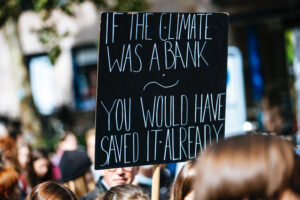UKRAINE WAR ACCELERATES ENERGY TRANSITION

Jeswin Thomas – Pexels
“Wars have unintended consequences.” So begins and recent New York Times article describing how Russia’s invasion of Ukraine is dovetailing with other developments to speed up the global energy transition from fossil fuels to renewables.
Times global climate correspondent, Somini Sengupta, invites us to consider three recent developments.
First, according to the International Energy Agency, an estimated $1.4 trillion poured into “clean energy” projects in 2022, a category that includes solar farms, batteries and electric vehicle charging stations. “That’s more than ever before.” she writes. Importantly, that is “more than the money that poured into new oil and gas projects” last year.
Second, Sengupta cites a report from BloombergNEF, which found that Investments in low-carbon energy (had) “reached parity” with capital aimed at expanding fossil fuels.
Finally, she quotes oil giant BP as saying that it expected the war in Ukraine to push countries to ramp up renewable energy projects for the sake of energy security. This is enormously consequential. In Sengupta’s words it means, “Energy security doesn’t mean fossil fuels anymore.”
No one owns the sun and the wind
Sengupta continues, “Nearly a year ago, right after the Russian invasion, the oil and gas industry made a full-throated pitch that it was key to energy security and affordability. For a while, there was lots of hand-wringing about whether the world’s climate goals would be sacrificed at the altar of energy security.
“But since then, renewable projects have been ramped up, not just on climate grounds, but rather in the name of energy security. Renewables are increasingly affordable, once they’re built, and they offer security as well.”
Sengupta cites other positive trends and developments from 2022 as well:
Financing still a constraint
What could stand in the way? Financing. Sengupta says there’s still a need for better financing terms for emerging economies. “I hear this often from diplomats and entrepreneurs trying to build renewable energy projects in countries like India, Brazil and South Africa,” she says. “It’s still way too expensive to borrow money.”
She quotes Fatih Birol, head of the International Energy Agency (IEA): “If you want to develop a solar project in Brazil or India, you’re likely to pay three times more for financing than if you were to build the same project in Europe.”
“That has huge climate implications,” Sengupta writes. “The energy demands of these big emerging economies are growing fast. If they can’t finance renewables, they’ll turn to gas instead. Or worse, to coal.” There’s still work to do.
Read Sengupta’s piece here.
Energy security for both electricity and heat from simple, abundant materials
People and businesses need both electricity and heat to survive and thrive. 247Solar’s HeatStorE™ thermal battery captures energy from PV, wind or the grid and stores it as heat in cheap, plentiful materials like sand or iron slag.
As a battery, HeatStorE converts stored heat to both heat and power (CHP) as needed for 9 hours or more on a single charge. As a backup system, HeatStorE produces both heat and power even when fully discharged by burning any locally available fuel, even hydrogen, ensuring 24/7 operation during even the longest grid outages.
HeatStorE enhances energy security and provides peace of mind with:
- Full uptime during natural emergencies or supply disruptions
- Fully dispatchable, 24/7 standby heat and power on demand
- Increased energy system reliability & operational flexibility
SOCIAL FACTORS HOLDING BACK RESPONSES TO CLIMATE CHANGE

Markus Spiske – Pexels
Consensus is growing that the goal of limiting global warming to 1.5°C is likely out of reach. This is variously attributed to many factors, but a recent report from Germany’s University of Hamburg (via The Hill) points to a contributing influence not often discussed. The authors of the Hamburg Climate Futures Outlook 2023 find that “social change is essential to meeting the temperature goals set in Paris. But what has been achieved to date is insufficient.”
The researchers addressed ten important drivers of social change. In summary, they found that none of the ten social drivers support “deep decarbonization” — achievement of the 1.5 target — by 2050. According to the report’s Key Findings:
“Seven social drivers — United Nations climate governance, transnational initiatives, climate-related regulation, climate protests and social movements, climate litigation, fossil-fuel divestment, and knowledge production — support decarbonization, but not deep decarbonization by 2050. Two social drivers — corporate responses and consumption patterns — continue to undermine the pathways to decarbonization, let alone deep decarbonization. One driver — media —remains ambivalent insofar as its dynamics are volatile, both supporting and undermining decarbonization.”
Say the authors, “The prospects of attaining the Paris Agreement temperature goals through deep decarbonization are fundamentally shaped by the interaction of social and physical dynamics.” The [report’s] social driver assessments demonstrate that human agency has a large potential to shape the way climate futures will evolve.”
In summary, “Meeting the 1.5°C Paris Agreement temperature goal is not plausible, but limiting the global temperature rise to well below 2°C can become plausible if ambition, implementation, and knowledge gaps are closed.”
Read more here.
NEW RENEWABLES NOW CHEAPER THAN MAINTAINING COAL PLANTS IN U.S.
A new report from Energy Innovation (via The Guardian) finds that “99 percent of the existing U.S. coal fleet is more expensive to run compared to replacement by new solar or wind.” This means, Oliver Miman of the Guardian writes, that “Coal in the US is now being economically outmatched by renewables to such an extent that it’s more expensive for 99% of the country’s coal-fired power plants to keep running than it is to build an entirely new solar or wind energy operation nearby.”
The article quotes Michelle Solomon, a policy analyst at Energy Innovation: “Coal is unequivocally more expensive than wind and solar resources, it’s just no longer cost competitive with renewables.” Does this mean that coal is going away overnight? Of course not. But, says Solomon, “There’s a huge opportunity here to invest in coal communities, build local economic resilience and save money in the process.”
Milman also quotes James Stock, an economist at Harvard University who was not involved in the report. “We can’t shutter all these plants tomorrow, we need to do it in an orderly fashion to support grid reliability but we should be able to do it in fairly fast order,” he says. “Coal has been on a natural decline due to economics and those economics are going to continue. This is a transition that’s just going to happen.”
Read The Guardian’s piece here.
FOLLOW & JOIN 247Solar
LinkedIn US, LinkedinEU, Twitter, YouTube
Contact: info@247solar.com
